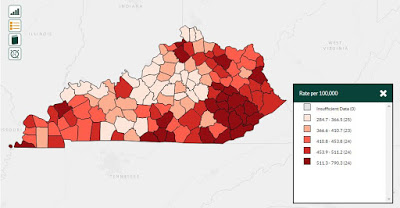Study finds a genetic marker determines a love for salty foods; says they should be considered a treat, like dessert

 |
| Heart-disease death rate for Kentuckians over 35 in 2012-14 (CDC map) |
A person’s desire for salty foods may be determined by their genes, and that could spell trouble for their heart, according to a recent study at the University of Kentucky.
The College of Nursing study found that individuals with a certain “taste perception genotype” were more likely to eat more than the recommended amount of daily sodium than people without the genotype, says a UK news release.
This matters because too much salt in your bloodstream can cause high blood pressure, or hypertension, one of the major risk factors for heart disease. And heart disease is the leading cause of death in the United States, killing about 610,000 Americans a year, or one in every four deaths, according to the federal Centers for Disease Control and Prevention.
Kentucky leads the nation in both heart disease and hypertension rates. Its death rate from heart disease is 394 per 100,000 people; the national rate is 328. Kentucky ranks sixth in the number of people diagnosed with hypertension, at 39 percent, according to the State of Obesity report. The report also projects that about 1.3 million Kentuckians will be diagnosed with heart disease by 2030.
 |
| Sources of salt you may not have thought about |
The release notes that the study paves the way toward future prevention opportunities, and that future research will help develop targeted approaches to reduce salt intake by people who are genetically predisposed to salty foods.
The American Heart Association recommends that most people eat no more than 2,300 milligrams of sodium per day (that’s one teaspoon of salt) and ideally no more than 1,500 mg. The AHA says about 77 percent of a person’s salt intake comes from prepared, packaged and restaurant foods.
An AHA graphic of “The Salty Six” shows six popular foods to pay attention to if you are watching your salt intake because they can add high levels of salt to your diet, including cold cuts and cured meats, pizza, soup, breads and rolls, chicken and burritos and tacos.
- Keep a journal of your salt intake (1/4 teaspoon salt = 575 mg sodium; 1/2 teaspoon salt = 1,150 mg sodium)
- Cook with minimal amounts of added salt, using herbs and spices instead.
- Read food labels.
- Opt for home-cooked meals so that you can control salt amounts
- Consider salty foods a treat, much like you would consider sugary treats
The AHA adds: “One estimate suggested that if the U.S. population moved to an average intake of 1,500 mg/day sodium from its current level, it could result in a 25.6 percent overall decrease in blood pressure and an estimated $26.2 billion in health care savings. Another estimate projected that achieving this goal would reduce deaths from cardiovascular disease by anywhere from 500,000 to nearly 1.2 million over the next 10 years.”